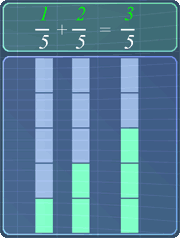Adding Fractions
Lesson Objective
In this lesson, we will learn the basics behind adding fractions with like denominators. We also will learn how to add fractions with unlike denominators.
About This Lesson
It is quite easy to add fractions after we have understood the basic ideas behind it.
This lesson will show you the important ideas that you need to know when adding fractions. We will be dealing with fractions with:
- Like denominators
- Unlike denominators
Here, you will able to see how Equivalent Fractions plays an important role when we add fractions with unlike denominators.

Study Tips
Tip #1 - Understand Equivalent Fractions
The idea behind equivalent fractions enables us to change the denominator of a fraction. If you are not very sure about it, click here to watch the math video.

Tip #2 - Adding fractions with like denominators
It is quite simple to add fractions that have like denominators. To do so, we simply add the numerators together while keeping the denominator the same.
This is illustrated in the picture below:

The math video below will explain why we can do so.
Tip #3 - Adding fractions with unlike denominators
To add fractions with unlike denominators, we need to:
- Make the denominators the same (like denominators)
- Then add the fractions, using the same way as shown in Tip #2
Now, we can make the denominators of these fractions to be the same by using the idea behind equivalent fractions. Scroll down to the math video below for more explanation.
Tip #4 - Shortcut to add fractions with unlike denominators
Fortunately, there is a short-cut to add fractions with unlike denominators. Below are the steps:

Step 1
Multiply both the denominators. This gives 10.

Step 2
Multiply 1 with the other fraction's denominator. This gives 5.

Step 3
Multiply 3 with the other fraction's denominator. This gives 6.

Step 4
Adding 5 with 6 gives 11. Hence, the resulting fraction is 11/10 . That is all.
Math Video
Lesson Video
Sponsored Links
Adding Fractions from MathExpression.com on Vimeo.
| |

Please support us by downloading our Fraction Basics app and subscribe to get all 12 video lessons and All Access pass to 8 Zapzapmath Home apps with 180 math games from as low as US$1.67/month:
Apple App Store (iOS) |
Google Play (Android)
Math Video Transcript
00:00:03.050
This lesson shows you the basics behind adding fractions.
00:00:07.220
Let's consider these 2 fractions, 1/5, and 2/5.
00:00:14.060
Now, we can visually represent these fractions using these 2 bars.
00:00:20.210
The denominator 5, means that, each bar is divided into 5 parts.
00:00:28.050
The numerator 1 here, means that 1 part of this bar is colored green.
00:00:33.200
Similarly, the numerator 2, means that 2 parts of this bar are colored green.
00:00:40.050
Alright, let us now understand the basics behind adding fractions.
00:00:46.030
We can see that, these fractions have like denominators, which make all these parts to have the same size.
00:00:54.060
This means that, it is possible to add these 2 fractions, because all the parts match perfectly.
00:01:01.150
So, when we add these two fractions, it is like placing this green part on the empty part here.
00:01:09.080
Now, let's focus on this bar, by analyzing it here.
00:01:14.200
From this, we can see that by adding fractions, it will result in a new fraction with the numerator of 3, and the denominator of 5.
00:01:27.170
Using this observation, we can get the same result through calculation, by just adding both the numerators together, 1 plus 2, which gives 3. And, by keeping the denominator the same.
00:01:43.000
Now, we can see that, by calculating this way, we get back the same fraction, 3/5.
00:01:54.040
Next example, let's add these fractions together, 2/3, and 1/6.
00:02:01.120
Notice that, these 2 fractions have unlike denominators.
00:02:08.030
This means that, the size of the parts are not the same, as you can see right here.
00:02:17.140
Because of this, we can visually see that, we cannot add these 2 fractions as they are.
00:02:26.140
Therefore, the only way to add these fractions, is to make all the parts to have the same size.
00:02:33.210
This means that, these fractions must have like denominators.
00:02:40.040
To do so, we need to use Equivalent Fractions that we learned from the last lesson.
00:02:45.190
Notice that, by using equivalent fractions, we can change this denominator to 6, by multiplying both the numerator and denominator of this fraction with 2.
00:02:57.220
This gives the fraction, 4/6.
00:03:02.180
Now, we can see that the fractions have like denominators. This means that, all the parts have the same size. As you can see here.
00:03:16.060
With this, we can now add these two fractions together just like the previous example. By doing so, we get, (4+1)/6.
00:03:28.040
Now, 4 plus 1 gives 5. Finally, we have the fraction, 5/6.
00:03:39.170
Next example, let's add, 2/3 with 1/2.
00:03:45.190
Again, notice that these fractions have unlike denominators. Hence, the size of these parts are not the same, as we can see here.
00:03:58.210
Therefore, in order to add these fractions, we need to make these fractions to have like denominators.
00:04:05.080
We can do so, by using equivalent fractions.
00:04:10.100
Note that, unlike previous example, we can only get like denominators here, by finding the equivalent fractions for both of these fractions.
00:04:20.060
Here's how. We can make both the denominator the same by multiplying 2/3, with the other fraction's denominator, 2, and multiply 1/2 with, the other fraction's denominator, 3.
00:04:35.160
Let's do it. Multiplying 2/3, with 2, and multiplying 1/2, with 3
00:04:43.030
This gives the equivalent fractions, 4/6, and 3/6 respectively. With this, now these 2 fractions have like denominators.
00:04:56.130
Alright, we now add these two fractions together like the previous examples. This gives, (4+3)/6.
00:05:07.230
Now, 4 plus 3, gives 7. So, we have the fraction, 7/6.
00:05:17.010
Notice that, 7/6 is an improper fraction. Now, rather than leaving the answer like this, it is recommended to change it to a mixed fraction, by using long division.
00:05:29.030
Here's how, 7/6 is the same as, 7 divide by 6. Now, this division gives the quotient 1.
00:05:40.170
This quotient is actually the whole number for the mixed fraction.
00:05:45.200
Next, we multiply 1 with 6. This gives 6. 7 minus 6 gives the remainder as 1.
00:05:57.110
This remainder, 1, is actually the mixed fraction numerator.
00:06:03.180
So here, we have successfully converted 7/6 to mixed fraction form, 1 1/6.
00:06:12.160
That is all for this lesson. Try out the practice question to further your understanding.
Practice Questions & More
Multiple Choice Questions (MCQ)
Now, let's try some MCQ questions to understand this lesson better.
You can start by going through the series of questions on Adding Fractions or pick your choice of question below.
- Question 1 on adding fractions with like denominators
- Question 2 on adding fractions with unlike denominators
Site-Search and Q&A Library
Please feel free to visit the Q&A Library. You can read the Q&As listed in any of the available categories such as Algebra, Graphs, Exponents and more. Also, you can submit math question, share or give comments there.


